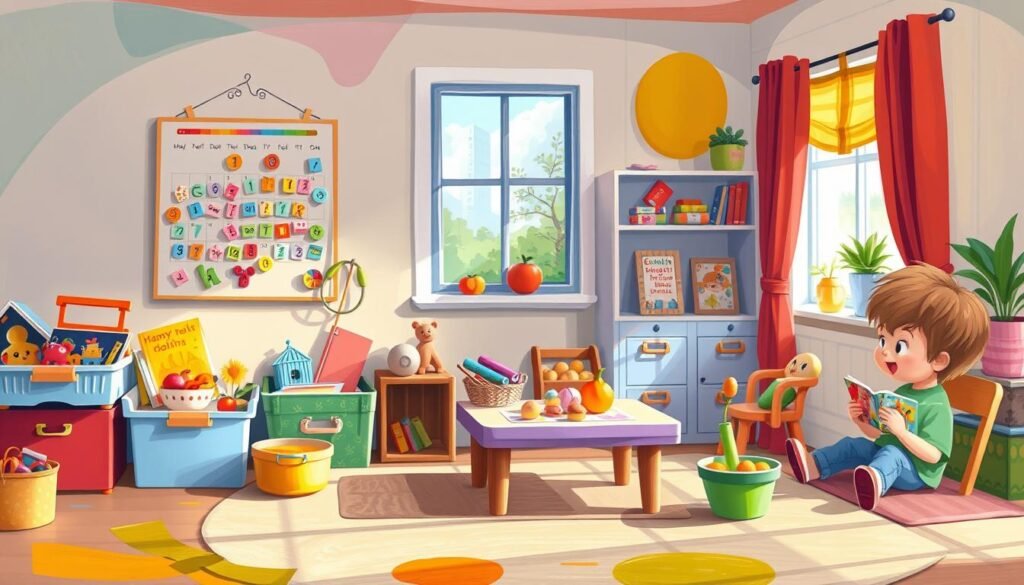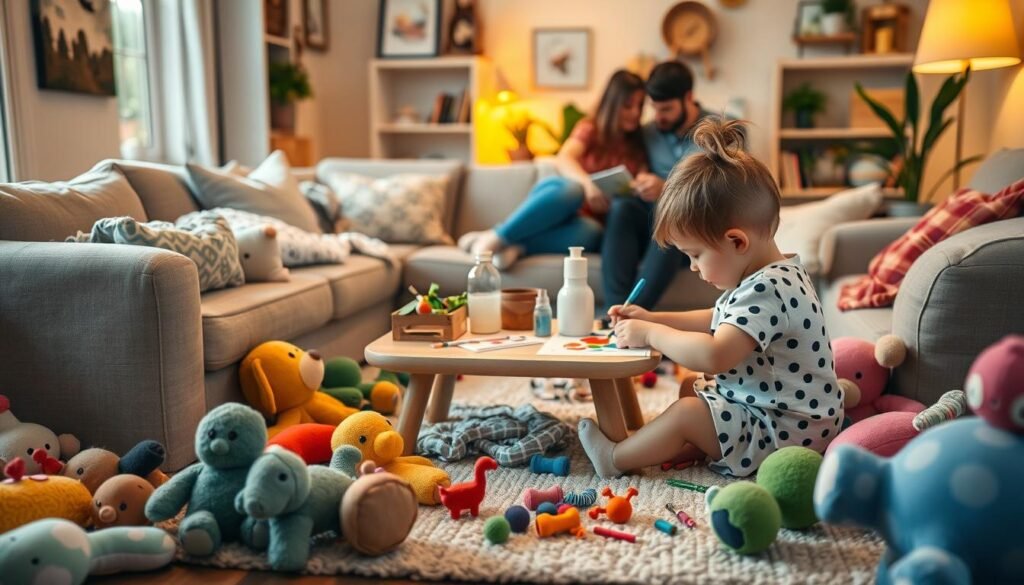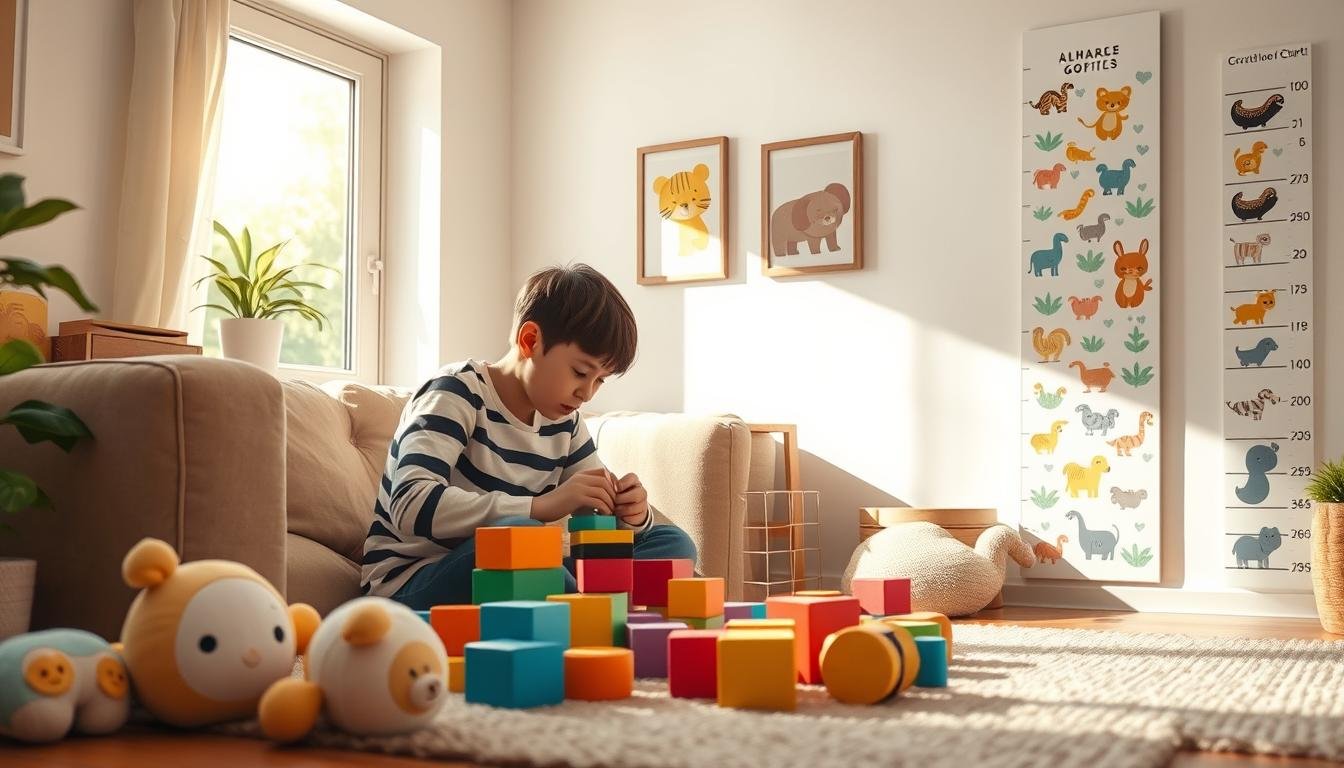As a parent, you might wonder what positive parenting tips can help your toddler grow. Advice often points to creating a caring space for your child’s growth. Positive parenting can greatly influence your child’s development. It’s key to find what works best for your little one.
According to the CDC, toddlers at 2-3 years old are going through big changes1. You might ask, how can you best support your toddler’s growth? What can you do to give them the best start in life?
Key Takeaways
- Positive parenting techniques can significantly impact a toddler’s development
- Toddlers at 2-3 years old are undergoing significant cognitive, emotional, and physical changes2
- Understanding what are two positive parenting tips for toddlers 2-3 years old can help you create a nurturing environment for your child
- Toddler parenting advice often emphasizes the importance of supervision, nutrition, and play1
- Positive parenting techniques for toddlers can help you address common behavioral challenges and support your child’s growth
- By incorporating positive parenting techniques into your daily routine, you can help your toddler develop essential skills and thrive during this critical developmental stage2
Understanding Your Toddler’s Development at 2-3 Years
Being a parent means knowing about the big changes in toddlers from 2-3 years old. This time is key for their growth and learning. By knowing these changes, you can help your toddler grow well and behave better.
Toddlers grow fast, learning to walk, talk, and control their feelings3. They might feel scared when you leave and love their caregivers a lot3. It’s important to show good behavior and create a safe place for them to explore and learn.
Some important things to watch for include:
- They start using longer sentences and ask lots of questions, like “why” and “no”4
- They play more complex games, like dressing up4
- They really care about their things and say “mine” a lot4
- They like to play with others and do things on their own, like washing hands4
By knowing these milestones and supporting them, you help your toddler learn important skills. Try to limit screen time to 30 minutes a day and encourage them to be active4. With patience and the right approach, your toddler will do great during this important time.
The Impact of Positive Parenting on Toddler Development
As a parent, you are key in shaping your toddler’s growth. Positive parenting greatly impacts their social, emotional, and cognitive development. It’s important to learn how to communicate with toddlers effectively to build trust and strengthen your bond5. By encouraging positive behavior in toddlers, you help them learn important skills like sharing and cooperation6.
Studies show that positive parenting boosts kids’ emotional and behavioral management. This can lead to a 40% increase in positive interactions with others6. Also, kids raised with positive parenting are 50% more likely to be cooperative in places like preschool6. Using positive reinforcement daily can lay a strong foundation for your child’s future success.
Here are some ways to encourage positive behavior in toddlers:
- Use positive language and reinforcement
- Set clear boundaries and expectations
- Encourage independence and self-regulation
By following these tips and learning how to communicate with toddlers effectively, you can help your child grow into a happy, healthy, and well-adjusted person7.
What Are Two Positive Parenting Tips for Toddlers 2-3
As a parent, you are key in building a strong bond with your child. Playing together and showing emotional support are vital. These actions help create a positive relationship and a nurturing environment for your child’s growth8.
Positive parenting also means encouraging free play for motor skill development8. Limiting screen time to one hour a day of quality shows is also important9. Emotional support helps your child manage feelings and avoid tantrums10.
Here are some benefits of positive parenting:
- Enhanced cognitive development
- Improved emotional regulation
- Stronger parent-child bond
By using these strategies, you can make a positive space for your child’s growth10.
Every child is different, so be patient and consistent. With support, you can build a strong bond and a positive environment for your child’s growth8.
| Positive Parenting Tip | Benefit |
|---|---|
| Consistent Communication Through Play | Enhanced cognitive development |
| Emotional Validation and Support | Improved emotional regulation |
Creating Your Positive Parenting Toolkit
As a parent, you want the best for your child. This includes giving them a strong start in life. Positive parenting techniques, like setting clear rules and encouraging independence, are key11. Toddler parenting advice stresses the need for a supportive environment that helps them grow.
A positive parenting toolkit has many strategies. These include using positive words and ignoring bad behavior12. These tools help manage your child’s actions and support their growth. This leads to a stronger bond between you and your child.
Some important parts of a positive parenting toolkit are:
- Setting clear boundaries and expectations
- Using positive language and reinforcement
- Encouraging independence and self-reliance
- Modeling good behavior and emotional regulation
By using these strategies every day, you create a positive space. This space supports your child’s growth and strengthens your bond13. Positive parenting aims to raise confident, capable, and caring kids. These kids are ready to succeed in life.
| Positive Parenting Techniques | Benefits |
|---|---|
| Setting clear boundaries | Encourages independence and self-reliance |
| Using positive language | Reinforces good behavior and promotes positive relationships |
| Modeling good behavior | Teaches children important life skills and values |
Implementing Effective Communication Strategies
As a parent, you are key in helping your toddler grow positively. One important way is through good communication. Using words your child can understand helps them grasp information better14. By 18 months, they might know 20 to 100 words. By 2, they start combining words14.
It’s also important to use body language and facial expressions. These help your child understand emotions and needs15. Active listening is another key. It helps create a caring space for your child to grow16.
Some good ways to talk to toddlers include giving clear directions and using the same words. Repetition helps too15. Asking your child to repeat what you said helps them remember15. Giving praise and feedback together makes them more open to listening16.
- Use words your child can understand to help them learn
- Use body language and facial expressions to show feelings
- Listen actively to create a caring space
- Give clear directions and use the same words
- Ask your child to repeat what you said and praise them
By following these tips, you can help your toddler grow well. This sets a strong base for their future social skills16.
Building a Structured Daily Routine

Creating a daily routine is a big help for toddlers. It gives them a sense of security and what to expect17. By adding tips for better toddler behavior to your routine, you can help them develop good habits and avoid tantrums. A good routine includes time for play, learning, and rest. This helps keep your child’s behavior in check and supports their growth18.
Some benefits of a daily routine include:
- Less arguing, as your child learns what comes next17
- Better social skills from regular interactions, like saying hello and goodbye17
- Better language skills and confidence from daily activities, like shopping17
Experts say to keep a regular schedule for snacks, baths, and bedtime to help with sleep18. Also, cut down on screen time and dim the lights before bed to help kids’ bodies adjust to sleep18. By using these tips for better toddler behavior and encouraging positive behavior in toddlers, you can make a routine that helps your child grow and feel good.
Remember, a good daily routine is consistent but also flexible. Make sure to mix structured activities with free playtime. This lets your child be themselves and explore18. With patience, the right tips for better toddler behavior, and a bit of effort, you can make a routine that fits your family and meets your child’s needs.
Managing Common Behavioral Challenges
Being a parent of a toddler comes with its own set of challenges. Tantrums, defiance, and sleep issues are common. Research shows that 99% of toddlers face these behaviors as they grow more independent and assertive between 2 and 3 years old19. Their emotional swings can be as fast as those in teenagers, showing how complex their emotional development is19.
To tackle these issues, positive parenting is key. This means staying calm, setting clear rules, and having a consistent bedtime routine.
Here are some effective ways to manage common behavioral challenges:
- Use positive reinforcement for good behavior
- Set clear boundaries and expectations
- Encourage communication and emotional expression
Almost 75% of toddlers have tantrums often, linked to their emotional growth20. By using positive parenting and staying calm, you can help your child manage their emotions better and have fewer tantrums.
Also, a consistent bedtime routine can help with sleep issues, common in toddlers. About 70% of parents see a link between their child’s challenging behaviors and lack of sleep or exhaustion20. By focusing on sleep and using positive reinforcement, you can help your child develop good sleep habits and reduce behavioral problems.
Fostering Independence While Maintaining Boundaries
As a parent, it’s vital to create a positive space for your toddler to grow. This means building a strong bond with your child. By letting them make choices and learn from mistakes, you help them grow independent. About 80% of 2-3 year olds can do simple tasks like putting on shoes21.
Offering choices can make them more cooperative, reducing resistance by 20%21.
Research shows that routines and boundaries are key for toddlers. A routine can lower tantrums by 30% as it makes them feel safe21. Also, using positive ways to engage, like asking questions, can reduce power struggles by 25%21.
These methods help build a positive space for independence and a strong bond with your child.
Some important ways to encourage independence and keep boundaries include:
- Offering choices to boost independence and teamwork
- Setting consistent routines and rules
- Using positive ways to engage, like asking questions, to lessen power struggles
By using these strategies, you can help your toddler grow independent while keeping a strong, positive bond. For more tips on positive parenting, check outpositive parenting tips for toddlers. Toddlers test boundaries 3-5 times a day, but being consistent and patient helps them learn22.
Creating a positive bond with your child is essential for their growth. By being consistent, patient, and positive, you help them become independent and successful. About 70% of parents see less conflict and more teamwork when they let their toddlers make simple choices21. Also, 75% of parents find that explaining boundaries helps their children understand and accept them23.
The Role of Positive Reinforcement
Understanding how to communicate with toddlers is key in promoting their development. Positive reinforcement is a big help in encouraging good behavior. By praising and rewarding positive actions, you create a supportive environment for growth24. This method is important for building a child’s self-esteem and confidence25.
Using praise and rewards correctly is essential. These tools can encourage sharing and following directions26. For instance, sticker charts work well for younger kids, while older ones might like token systems26. By using these strategies, you can encourage good behavior and reduce bad ones24.
Positive reinforcement has many benefits, including:
- Increased self-esteem and confidence in children25
- Reduced power struggles and behavioral issues24
- Improved cooperation and willingness to try new behaviors26
By understanding positive reinforcement and using praise and rewards, you can help your child grow in a supportive environment25.
| Age Group | Effective Reward Systems |
|---|---|
| Younger Children | Sticker Charts |
| Older Children | Token Economy Systems |
Creating a Supportive Home Environment

As a parent, you are key in shaping your child’s growth. Toddler parenting advice highlights the importance of a supportive home environment. It should be safe, nurturing, and encourage learning and growth. Research shows that 80% of parents find that a predictable schedule makes their children feel safer and happier27.
Setting up a daily routine that includes play, learning, and rest is a good start. This routine helps your child feel secure and happy.
Using positive parenting techniques, like positive reinforcement and clear expectations, is also vital. For instance, descriptive encouragement can boost a child’s confidence by up to 25%27. Techniques like sustained eye contact and gentle touch can improve communication by 35%27. These methods help create a supportive environment for your child’s development.
Ensuring your child’s physical safety is also critical. Drowning is a leading cause of injury and death among toddlers28. Always supervise your child near water to prevent accidents. Also, use a rear-facing car seat until your child reaches the manufacturer’s height or weight limit to prevent injuries2829.
By following these tips, you can help your child grow into a happy, healthy, and well-adjusted individual. For more information on parenting techniques, visit parentingateenager.net. There, you can learn more about positive parenting techniques for toddlers and toddler parenting advice.
| Age | Recommended Sleep | Physical Activities |
|---|---|---|
| 1-2 years | 11-14 hours | Running, climbing, jumping |
| 2-3 years | 12-15 hours | Dancing, kicking, throwing |
Conclusion: Embracing the Journey of Positive Parenting
Parenting toddlers aged 2-3 is both rewarding and challenging. Embracing positive parenting is key. It means creating a caring space and building a strong bond with your child30.
Patience, understanding, and using effective parenting strategies are vital. About 84% of parents meet their kids’ emotional and physical needs by being responsive30. This helps kids feel secure and learn to manage their feelings better30.
As you face the “terrible twos” and more, let this advice help you. It’s about setting a daily routine, handling behavior issues, and teaching independence while keeping boundaries. Positive parenting shapes your child’s growth in big ways31.
Approach this journey with openness and self-reflection. 70% of parents say thinking about their actions improves their parenting30. With patience, love, and a focus on nurturing, you can build a strong bond with your toddler. This sets them up for future success.
FAQ
What are the two positive parenting tips for toddlers 2-3 years old?
How can I understand my toddler’s development at 2-3 years?
What is the impact of positive parenting on toddler development?
How can I implement the two positive parenting tips for toddlers 2-3 years old?
What should I include in my positive parenting toolkit for toddlers?
How can I communicate effectively with my toddler?
Why is a structured daily routine important for toddlers?
How can I manage common behavioral challenges with my toddler?
How can I foster independence in my toddler while maintaining boundaries?
What is the role of positive reinforcement in toddler development?
How can I create a supportive home environment for my toddler?
Source Links
- Positive Parenting Tips for Toddlers (1-3 years) – https://americanspcc.org/toddlers-1-3-years/
- 2-3 years: toddler development – https://raisingchildren.net.au/toddlers/development/development-tracker-1-3-years/2-3-years
- Child development: Toddlers (1-3 years) – https://www.schn.health.nsw.gov.au/kids-health-hub/child-development/child-development-toddlers-1-3-years
- Your toddler 2-3 years | GOV.WALES – https://www.gov.wales/parenting-give-it-time/your-childs-development/your-toddler-2-3-years
- Positive Parenting Tips: 2 and 3 Year Olds – https://www.first5nevada.org/news-and-articles/positive-parenting-tips-2-and-3-year-olds/
- A positive approach to discipline: babies and children – https://raisingchildren.net.au/toddlers/behaviour/discipline/discipline-positive-approach-babies-children
- Parenting and Child Development in Infants and Toddlers – https://psychcentral.com/health/purposeful-parenting-the-infant-or-toddler
- Positive Parenting Tips: Toddlers (2–3 years old) – https://www.cdc.gov/child-development/positive-parenting-tips/toddlers-2-3-years.html
- Positive Parenting Tips for Toddlers (2-3) – https://obgynhealthplus.org/maternity-and-motherhood/positive-parenting-tips-for-toddlers-(2-3)
- Positive Parenting Tips for Your 2-year-old – https://imperfectfamilies.com/tips-parenting-2-year-old/
- Power of Positive Discipline – Toddlers & Preschoolers – Discipline – https://getparentingtips.com/toddlers/discipline/power-of-positive-discipline/
- The Secret to Your 2-Year-Old’s Heart (and gaining their cooperation) – https://nurtureandthriveblog.com/parenting-your-2-year-old/
- Parenting Tool Kit – Page 2 of 12 – The Med School Wife – https://www.themedschoolwife.com/parenting-tool-kit/2/
- Toddler talking and communication: what to expect and how to help – https://raisingchildren.net.au/toddlers/connecting-communicating/communicating/toddlers-talking
- Talking to Toddlers – Child Mind Institute – https://childmind.org/article/talking-to-toddlers/
- Communicating well with babies and children: tips – https://raisingchildren.net.au/toddlers/connecting-communicating/communicating/communicating-well-with-children
- Creating Routines for Love and Learning – https://www.zerotothree.org/resource/creating-routines-for-love-and-learning/
- Daily Toddler Schedule: Routines and Sample to Follow – https://www.healthline.com/health/parenting/toddler-schedule
- Toddlers and Challenging Behavior: Why They Do It and How to Respond – https://www.zerotothree.org/resource/toddlers-and-challenging-behavior-why-they-do-it-and-how-to-respond/
- Challenging behaviour – toddlers and young children – https://www.rch.org.au/kidsinfo/fact_sheets/challenging_behaviour_toddlers_and_young_children/
- Growing Independence: Tips for Parents of Toddlers and Twos – https://www.naeyc.org/our-work/families/growing-independence-tips-parents-toddlers-and-twos
- Setting Limits With Toddlers – The Choices They Can’t Make – Janet Lansbury – https://www.janetlansbury.com/2012/05/setting-limits-with-toddlers-the-choices-they-cant-make/
- Setting boundaries for toddlers and preschool children – https://www.familylives.org.uk/advice/early-years-development/behaviour/setting-boundaries-for-toddlers-and-preschool-children
- Using Positive Reinforcement on Your Toddler – https://www.whattoexpect.com/toddler-behavior/teaching-positive-reinforcement.aspx
- Encouraging positive behaviour: tips – https://raisingchildren.net.au/toddlers/behaviour/encouraging-good-behaviour/good-behaviour-tips
- How Positive Reinforcement Encourages Good Behavior in Kids – https://www.parents.com/positive-reinforcement-examples-8619283
- Positive Guidance: A Guide for Parents – https://www.brighthorizons.com/resources/article/positive-guidance-guide-for-parents
- Positive Parenting Tips: Toddlers (1–2 years old) – https://www.cdc.gov/child-development/positive-parenting-tips/toddlers-1-2-years.html
- Toddler Health & Safety – https://www.michigan.gov/mikidsmatter/parents/toddler/health
- What is Responsive Parenting? – https://mommy-diary.com/what-is-responsive-parenting/
- Positive Parenting Tips for Toddlers 2-3 years – https://4akid.co.za/blogs/parenting-advice/positive-parenting-tips-for-toddlers-2-3-years?srsltid=AfmBOorwi_ntLROSqZZPynxDayAPBIat-0i-fhMrCG-XKEh4ACv1ABnc








0 responses to “2 Positive Parenting Tips for Toddlers 2-3 Years Old”
Could the positive parenting tips also be applied to slightly older kids, say 4-5 years? Also, how to manage tantrums effectively?
Interesting read. But arent the terrible twos a myth? Shouldnt we approach parenting more individually rather than age-specifically? Thoughts?